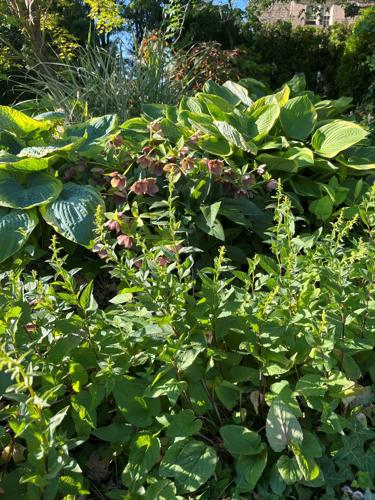In mythology, the Campanula family of bellflowers has long been associated with witches and fairies. Campanula rapunculus is the bellflower that gives the fairy tale “Rapunzel” its name. It’s the story of a couple who long for a child. Their home overlooks a beautiful garden full of rampion, known botanically as Campanula rapunculus.
This wildflower was grown widely in Europe as an edible vegetable. The leaves were used like spinach, and its parsnip-like root was eaten like a radish.
The couple was forbidden from going into the garden by its owner, a wicked witch. One day, the wife has an uncontrollable craving for rampion, so her husband sneaks into the garden and steals some. When he returns to pick more, he’s caught by the witch.
The witch makes him a proposition. If the man promises to give her his first-born child, he can have all the rampion he wants. The husband reluctantly agrees.
The deal does not go well for the family.
I have my own tragic story about another Campanula.
“-oides” in Greek means “likeness.” In horticulture, the suffix is used for species that resemble other species. C. rapunculoides is “like” C. rapunculus, but they aren’t the same. C. rapunculoides has been called “cancer of the garden” and holds a place on most invasive-plant lists.
It’s growing exuberantly in each of my garden beds, and even in the lawn. I’ve spotted it in many Yakima gardens.
While each plant can produce 15,000 seeds, that’s only the tip of the iceberg.
Campanula rapunculoides has storage roots called stolons that grow beyond the white parsnip-like roots that come out when you pull the plant from your flower bed. You may think you’ve got the whole shebang, but you’ve left behind plenty of stolons. It doesn’t matter that these storage roots have no stems and leaves. They will vigorously re-grow, often at some distance from the mother plant, quickly sending up new flowering stems.
This survival mechanism allows that if part of the plant is eaten or destroyed, an army of clones stands ready to re-colonize.
As in life, so much of gardening depends on knowing when to fight, when to surrender, and when to look the other way until you can make up your mind.
Forty years ago and new to gardening, I found C. rampunculoides growing in a corner of our yard. Charmed by the delightful lavender bellflowers, I moved it to my new garden.
Just a few years later, it was everywhere. I knew I had a problem.
I’ve tried to remove it with a shovel accompanied by loud cursing. This involves digging down 6-9 inches deep all around the plant, loosening the soil, and carefully prying out the fleshy roots. Forget it if your soil is heavy.
Honestly, I think this technique only serves to propagate more plants, since any fragments inadvertently left behind will re-grow.
If you take the digging route, vigilantly look for the emergence of new plants and destroy them immediately. In principle, doing this repeatedly should starve the storage reserves, ultimately killing them.
Over the years, C. rampunculoides has invaded clumps of very desirable perennials. When that happens, I consider the battle lost. I dig up the whole mess and dump it in the garbage. Unless you hot compost, C. rampunculoides roots do not belong in your average compost pile.
As with other noxious weeds, you could try smothering C. rampunculoides by covering plants with newspaper or cardboard, held down with soil or mulch.
Some suggest solarizing, which means covering the plants with black plastic held in place with rocks or soil. The hope is that enough heat will build up under the plastic to kill the roots.
I’ve talked to other Yakima gardeners about this plant, and we all agree on one thing. Ridding our gardens of this thug is a struggle that will take years, at best. I learned that the stolons of C. rapunculoides can go dormant for a year. Barely alive, they are just messing with you, biding their time before growing a stem and starting the process all over again.
I have hundreds of C. rapunculoides. I pull what I can. Otherwise, I treat it as a cut flower, which at least prevents it from spreading by one of those 15,000 seeds. Used in bouquets, it’s lovely, and everyone wants to know what that beautiful lavender flower is. ...
Non-chemical and chemical control techniques can be found online in the “Creeping Bellflower Factsheet” by the University of Wisconsin-Extension.
Good luck. And call me right away if anything works.
• Carol Barany and her husband, John, found paradise on 1 1/3 acres just west of Franklin Park, where they raised three children and became Master Gardeners. Contact her at florabundance14@gmail.com.






(0) comments
Comments are now closed on this article.
Comments can only be made on article within the first 3 days of publication.